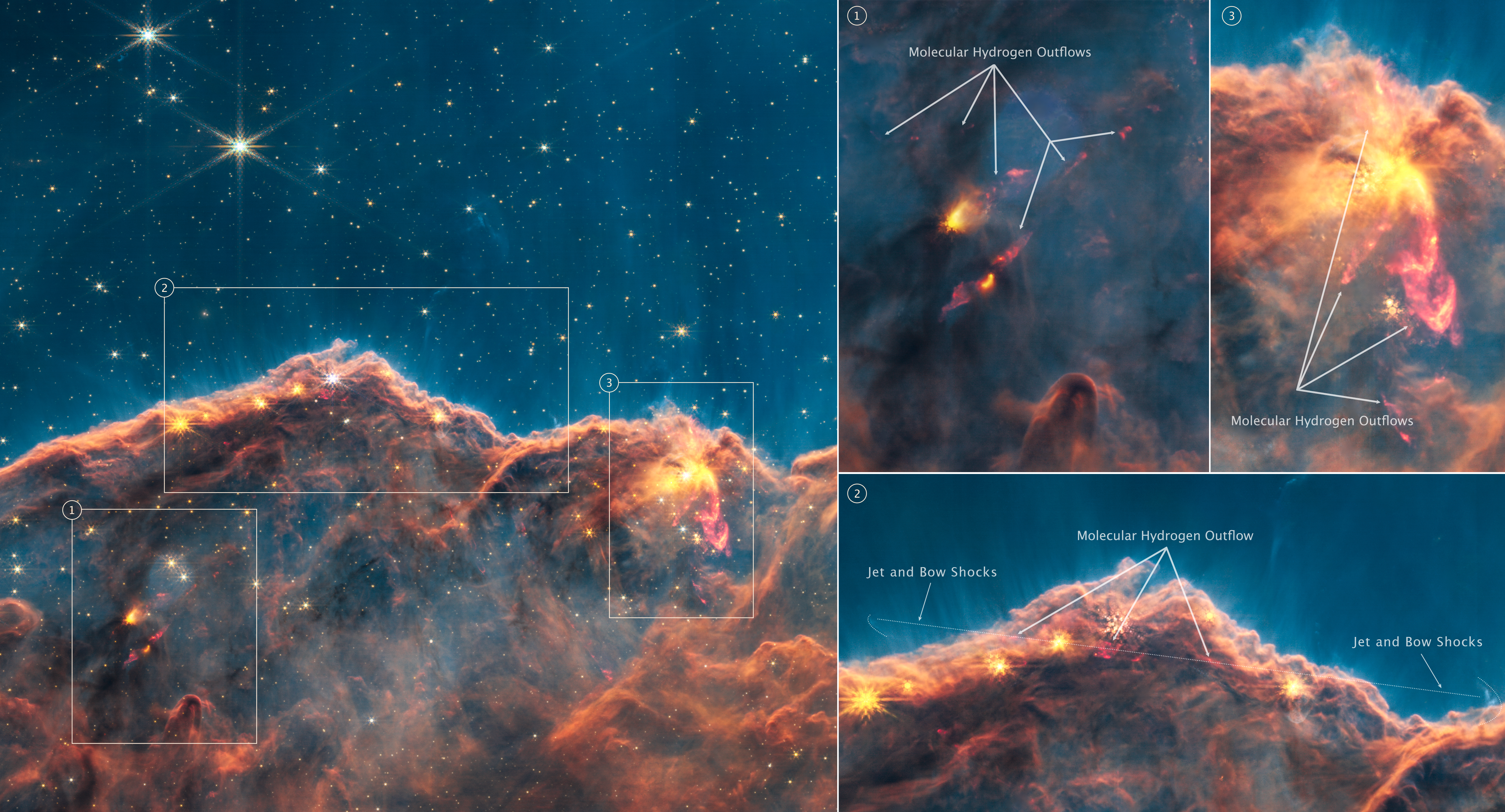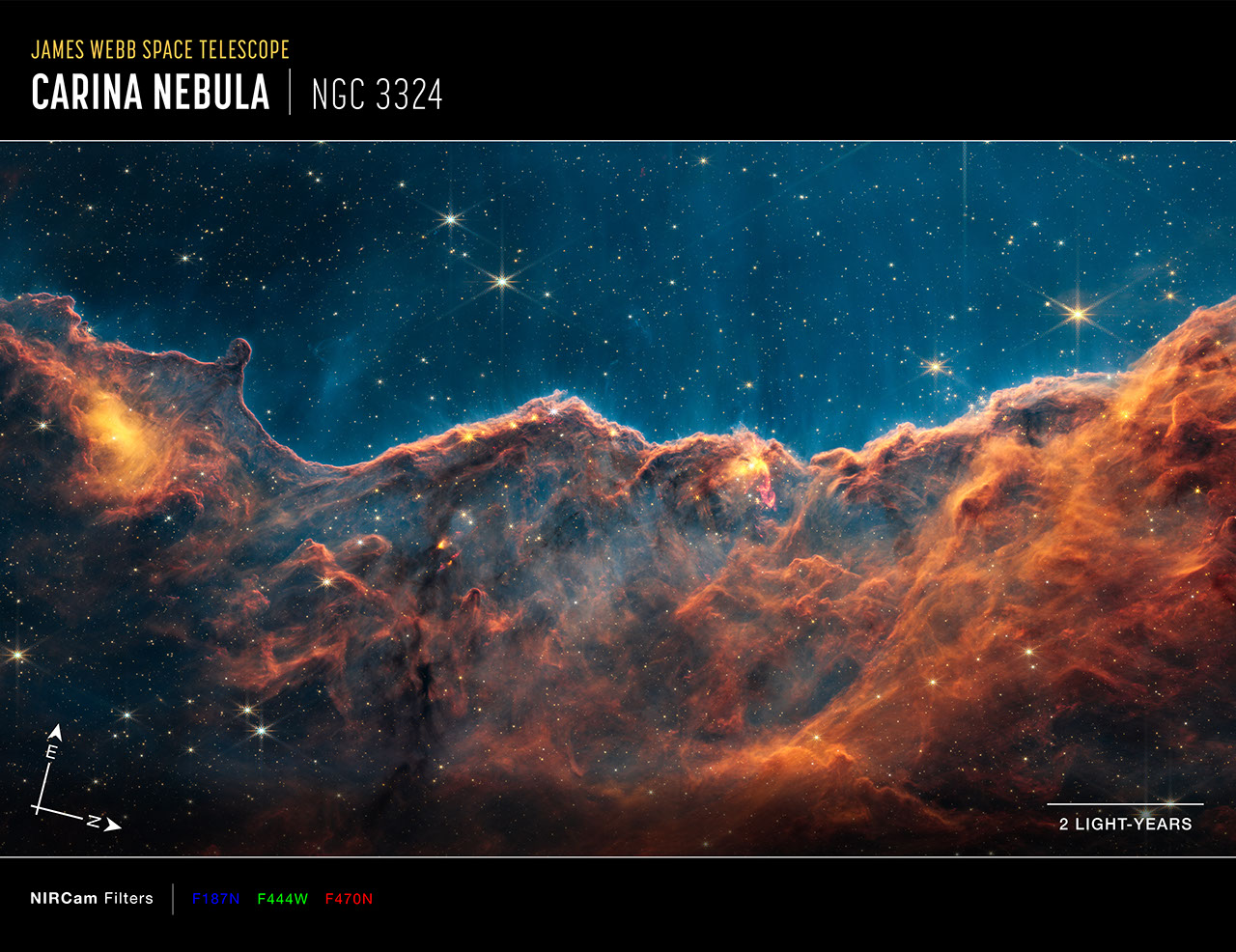1 min read
Carina Nebula Jets (NIRCam Narrowband Filters)

Dozens of previously hidden jets and outflows from young stars are revealed in this new image of the Cosmic Cliffs from NASA’s James Webb Space Telescope’s Near-Infrared Camera (NIRCam). The Cosmic Cliffs, a region at the edge of a gigantic, gaseous cavity within NGC 3324, has long intrigued astronomers as a hotbed for star formation.
Many details of star formation in NGC 3324 remain hidden at visible-light wavelengths. Webb is perfectly primed to tease out these long-sought-after details since it can detect jets and outflows seen only in the infrared at high resolution.
This image separates out several wavelengths of light from the iconic First Image revealed on July 12, 2022 which highlight molecular hydrogen, a vital ingredient for star formation. Insets on the right-hand side highlight three regions of the Cosmic Cliffs with particularly active molecular hydrogen outflows.
In this image, red, green, and blue were assigned to Webb’s NIRCam data at 4.7, 4.44, and 1.87 microns (F470N, F444W, and F187N filters, respectively).
Webb’s NIRCam was built by a team at the University of Arizona and Lockheed Martin’s Advanced Technology Center.
About the Object
- R.A. PositionR.A. PositionRight ascension – analogous to longitude – is one component of an object's position.10:36:59.0
- Dec. PositionDec. PositionDeclination – analogous to latitude – is one component of an object's position.-58:37:00.0
- ConstellationConstellationOne of 88 recognized regions of the celestial sphere in which the object appears.Carina
- DistanceDistanceThe physical distance from Earth to the astronomical object. Distances within our solar system are usually measured in Astronomical Units (AU). Distances between stars are usually measured in light-years. Interstellar distances can also be measured in parsecs.7,600 light-years (2,300 parsecs)
- DimensionsDimensionsThe physical size of the object or the apparent angle it subtends on the sky.Main image is about 7.3 arcminutes across (about 16 light-years)
About the Data
- Data DescriptionData DescriptionProposal: A description of the observations, their scientific justification, and the links to the data available in the science archive.
Science Team: The astronomers who planned the observations and analyzed the data. "PI" refers to the Principal Investigator.This image was created with Webb data from proposal 2731 . It is part of Webb Early Release Observations.
The Early Release Observations and associated materials were developed, executed, and compiled by the ERO production team:
Jaclyn Barrientes, Claire Blome, Hannah Braun, Matthew Brown, Margaret Carruthers, Dan Coe, Joseph DePasquale, Nestor Espinoza, Macarena Garcia Marin, Karl Gordon, Alaina Henry, Leah Hustak, Andi James, Ann Jenkins, Anton Koekemoer, Stephanie LaMassa, David Law, Alexandra Lockwood, Amaya Moro-Martin, Susan Mullally, Alyssa Pagan, Dani Player, Klaus Pontoppidan, Charles Proffitt, Christine Pulliam, Leah Ramsay, Swara Ravindranath, Neill Reid, Massimo Robberto, Elena Sabbi, Leonardo Ubeda.
The EROs were also made possible by the foundational efforts and support from the JWST instruments, STScI planning and scheduling, Data Management teams, and Office of Public Outreach.
- InstrumentInstrumentThe science instrument used to produce the data.NIRCam
- Exposure DatesExposure DatesThe date(s) that the telescope made its observations and the total exposure time.3 June 2022
- FiltersFiltersThe camera filters that were used in the science observations.F187N, F444W, F470N
- Object NameObject NameA name or catalog number that astronomers use to identify an astronomical object.NGC 3324, Carina Nebula
- Object DescriptionObject DescriptionThe type of astronomical object.Star-forming region in the Carina Nebula
- Release DateDecember 15, 2022
- Science ReleaseNASA’s Webb Unveils Young Stars in Early Stages of Formation
- CreditImage: NASA, ESA, CSA, STScI; Science: Megan Reiter (Rice University); Image Processing: Joseph DePasquale (STScI), Anton Koekemoer (STScI)
Downloads

These images are a composite of separate exposures acquired by the James Webb Space Telescope using the NIRCam instrument. Several filters were used to sample narrow and broad wavelength ranges. The color results from assigning different hues (colors) to each monochromatic (grayscale) image associated with an individual filter. In this case, the assigned colors are: Red: F470N, Green: F444W, Blue: F187N

Related Images & Videos

Carina Nebula Jets (NIRCam Narrowband Filters Compass Image)
Image of the Cosmic Cliffs, a region at the edge of a gigantic, gaseous cavity within NGC 3324, captured by Webb’s Near-Infrared Camera (NIRCam), with compass arrows, scale bar, and color key for reference. The north and east compass arrows show the orientation of the image on...
Share
Details
Laura Betz
NASA’s Goddard Space Flight Center
Greenbelt, Maryland
laura.e.betz@nasa.gov
NASA, ESA, CSA, STScI
Megan Reiter (Rice University)
Joseph DePasquale (STScI), Anton Koekemoer (STScI)






























